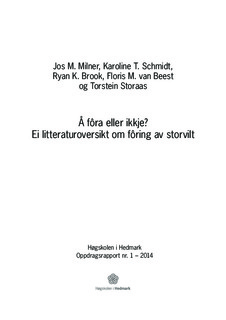| dc.contributor.author | Milner, Jos M. | |
| dc.contributor.author | Schmidt, Karoline T. | |
| dc.contributor.author | Brook, Ryan K. | |
| dc.contributor.author | van Beest, Floris M. | |
| dc.contributor.author | Storaas, Torstein | |
| dc.date.accessioned | 2014-01-20T11:20:11Z | |
| dc.date.available | 2014-01-20T11:20:11Z | |
| dc.date.issued | 2014 | |
| dc.identifier.isbn | 978-82-7671-912-3 | |
| dc.identifier.issn | 1501-8571 | |
| dc.identifier.uri | http://hdl.handle.net/11250/133721 | |
| dc.description.abstract | Ettersom storviltbestandane i Europa og Nord-Amerika har auka, ser folk ogso ulemper med tette bestandar. For å minska ulempene utan å redusera viltbestandane, har mange byrja å fôra.
2. Me har gått gjennom all tilgjengeleg litteratur for å sjå om forvaltarane nådde måla med fôringa og om fôringa hadde andre, ikkje planlagde fylgjer.
3. Me fann klare bevis for at fôring i periodar med lite anna fôr førde til større bestandar der kvart individ reproduserte betre. Haustvektene vart ikkje høgare ved fôring, haustvektene vart bestemt av sumarfôret. Me fann ikkje bevis for at forvaltarane klarte ved hjelp av fôring å trekkja beitinga bort frå innmark, ung furuskog eller andre attraktive matkjelder, truleg fordi det tilførde fôret ikkje tilfredsstilte nærings- og oppførselsbehova til viltet og fordi fôringa førde til tettare bestandar. Undersøkjingar viser at fôring har minska talet på påkøyrsler, men fleire undersøkjingar trengst for å få full visse.
4. Samling av mykje storvilt rundt fôringsplassar påverkar omgjevnadene. Effektane kan vera komplekse endringar i vegetasjonssamansetning og struktur. Dette kan påverka andre arter i systemet. Nokre sjukdomar vert lettare overførte når dyr samlar seg som rundt fôringsplassar. Ikkje planlagde fylgjer av fôring er lite studert, noko som gjer det vanskeleg å føreseia fylgjene.
5. Det er vanskeleg å rekna på økonomien for den einskilde jaktrettshavar då storviltbestandar gjerne kryssar eigedomsgrenser frå jakttid til fôringstid og ein ofte ikkje kjenner alle fylgjene. Fôringa fører gjerne til høgare og meir reproduktive bestandar og det kan vera vanskeleg å skilja negative verknader av det å fôra og det å ha tette bestandar. Tette bestandar kan ha langtidsverknader som folk kan oppfatta som bra eller dårlege. Før nokon set i gang større program med fôring av storvilt, bør dei grundig vurdera alle sider ved fôring og ha solid stønad frå grunneigarane i viltbestanden sitt heiltårsleveområde. Dersom dei vil slutta fôringa, må dei fyrst redusera viltbestanden.
6. Me har laga ei liste (kapittel 4.3) med punkt som forvaltarar bør gå gjennom og drøfta om dei vurderer å byrja fôra vilt. | no_NO |
| dc.description.abstract | English: There are costs and benefits associated with large herbivore populations. As populations have grown, conflicts have arisen between stakeholders who benefit from high numbers and those faced with the costs. Feeding may potentially mitigate conflicts while maintaining harvest yields.
2. We created a series of hypotheses associated with the intended management goals of large herbivore feeding programmes and the commonly perceived unintended consequences. We quantified the empirical evidence in support of each hypothesis and established which factors determined the effectiveness of feeding and under what conditions unintended effects may occur.
3. We found clear and consistent evidence of demographic consequences of supplementary feeding. Reproduction and population size were enhanced in food-limited populations, where a high proportion of females had access to feed throughout the limiting season. By contrast, we found limited evidence of the effectiveness of diversionary feeding to protect crops, forestry and natural habitats, largely because any positive effects were undermined by high herbivore densities. The use of diversionary feeding to reduce traffic collisions requires further investigation.
4. Evidence indicates that unintended effects of feeding are likely when feeding causes aggregation and high densities, and when feed type does not match the foraging strategy of the target species. Unintended effects can be complex, involving habitat impacts, such as changes to vegetation composition and structure, with consequent cascading effects through the trophic levels. Disease transmission risks are also often increased. Unintended effects are generally less well studied, making clear predictions difficult.
5. The economic costs and benefits of feeding are typically borne by different stakeholder groups and may occur over different time-frames. Ethical views of feeding also vary between groups, ranging from obligation to undesirable step towards domestication. The risks of unintended consequences are likely to increase with longevity of feeding and should be considered at the outset.
6. We have written a list (chapter 4.3) with points that managers should discuss if they consider feeding wildlife. | en |
| dc.language.iso | nno | no_NO |
| dc.relation.ispartofseries | Oppdragsrapport;1/2014 | |
| dc.subject | hjortevilt | no_NO |
| dc.subject | viltforvaltning | no_NO |
| dc.subject | fôring | no_NO |
| dc.subject | viltkollisjonar | no_NO |
| dc.subject | økonomi | no_NO |
| dc.title | Å fôra eller ikkje? Ei litteraturoversikt om fôring av storvilt | no_NO |
| dc.type | Research report | no_NO |
| dc.source.pagenumber | 33 | no_NO |
